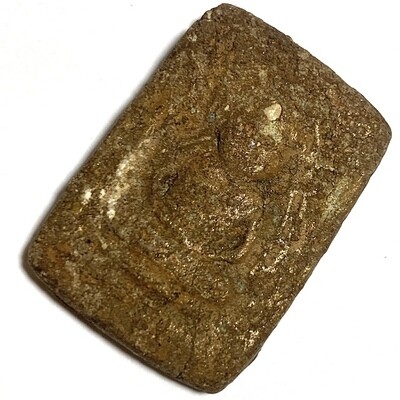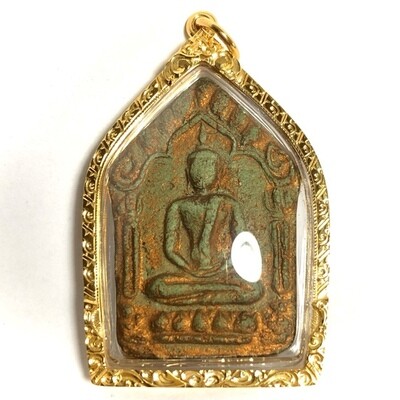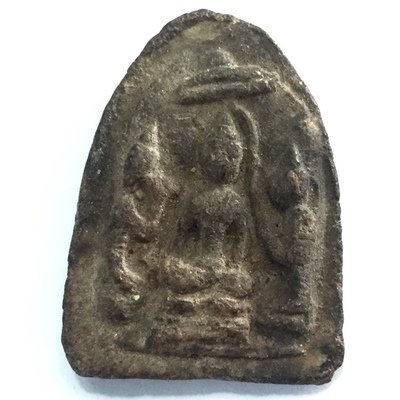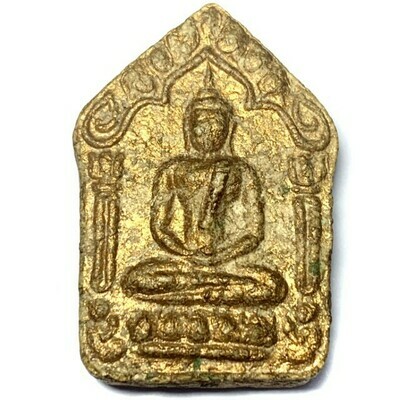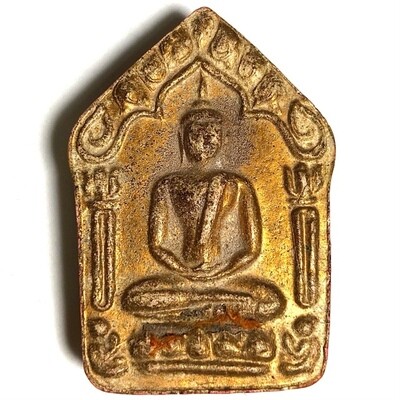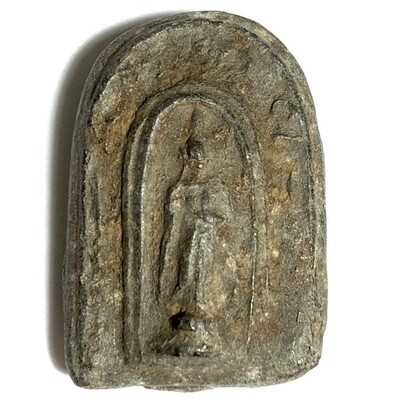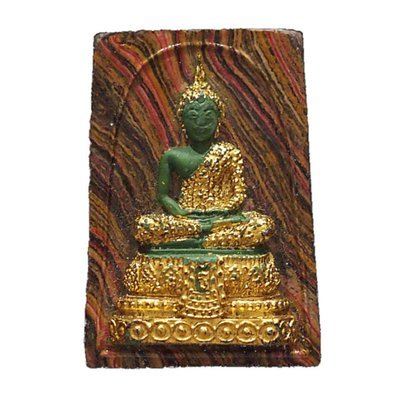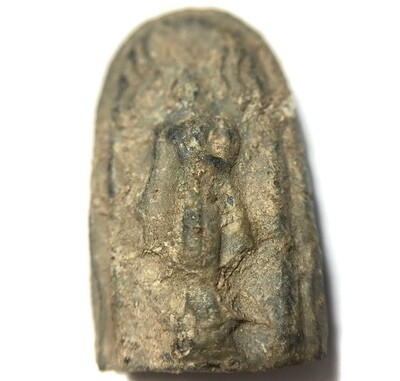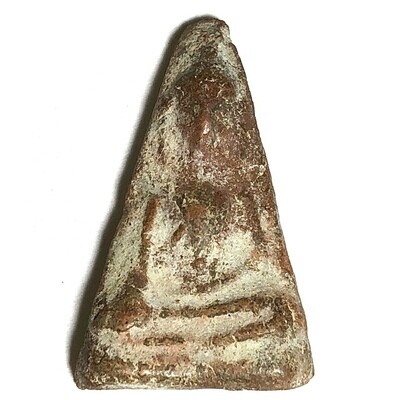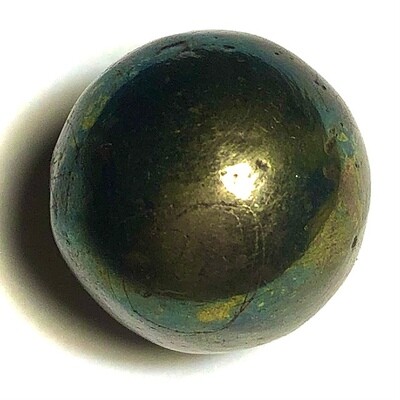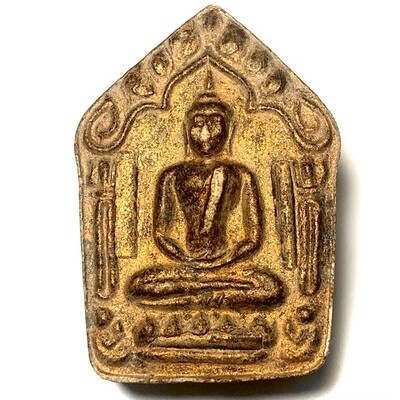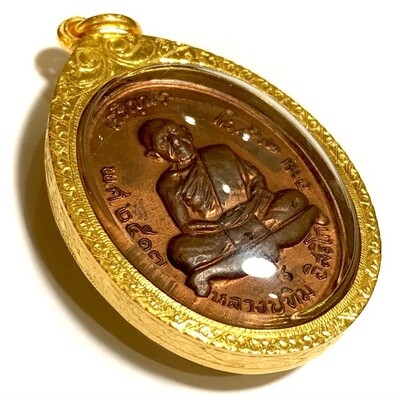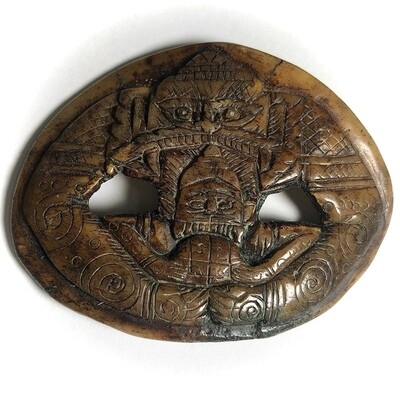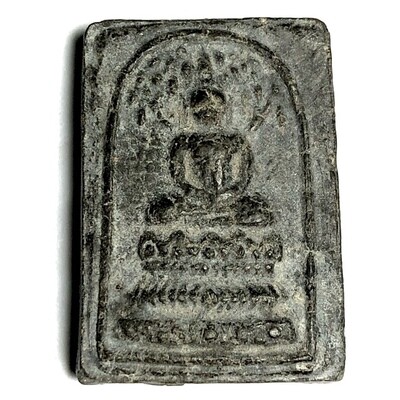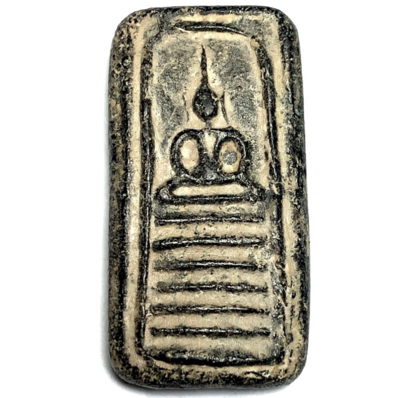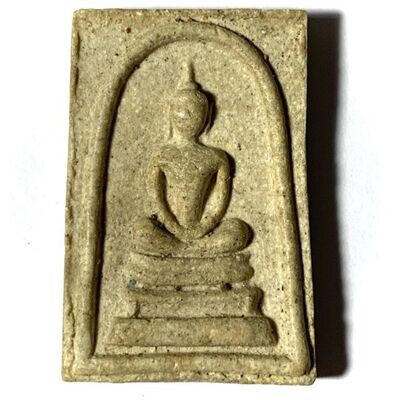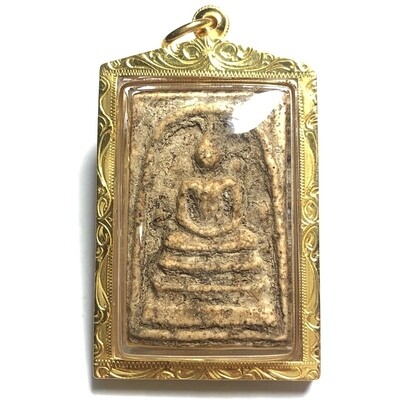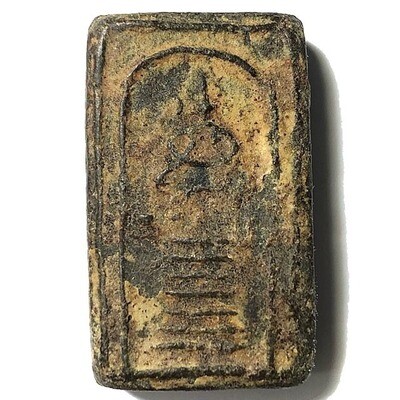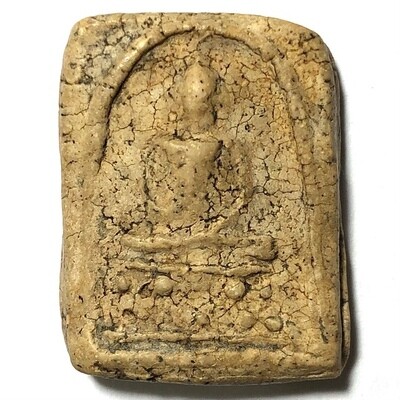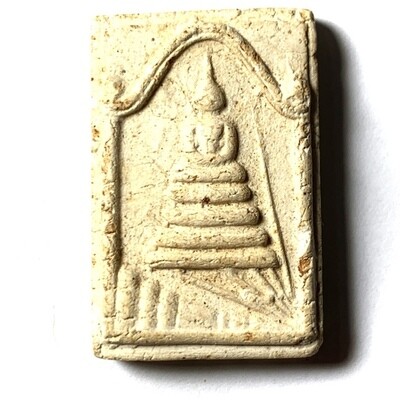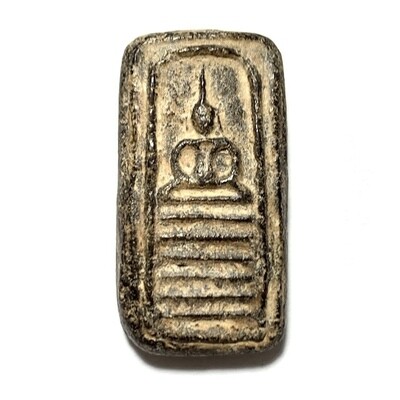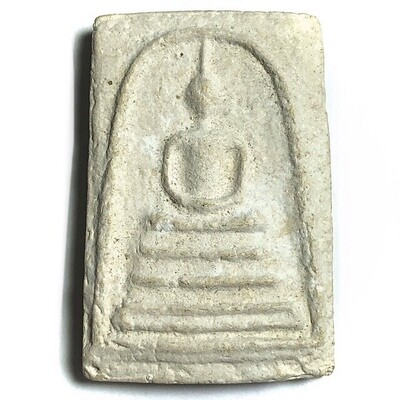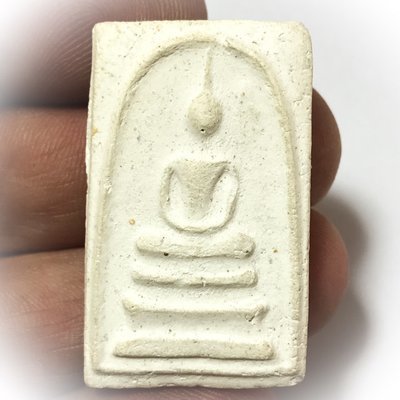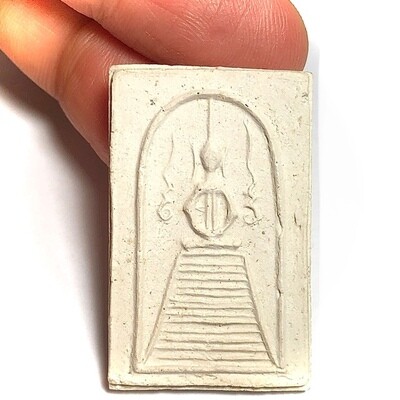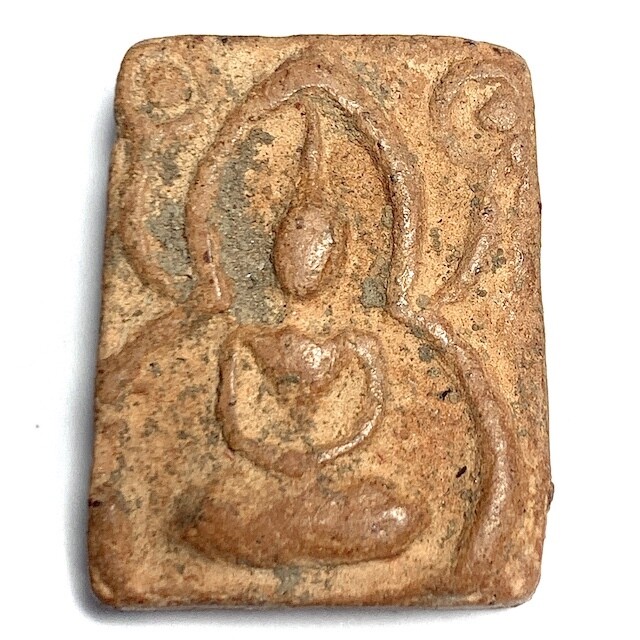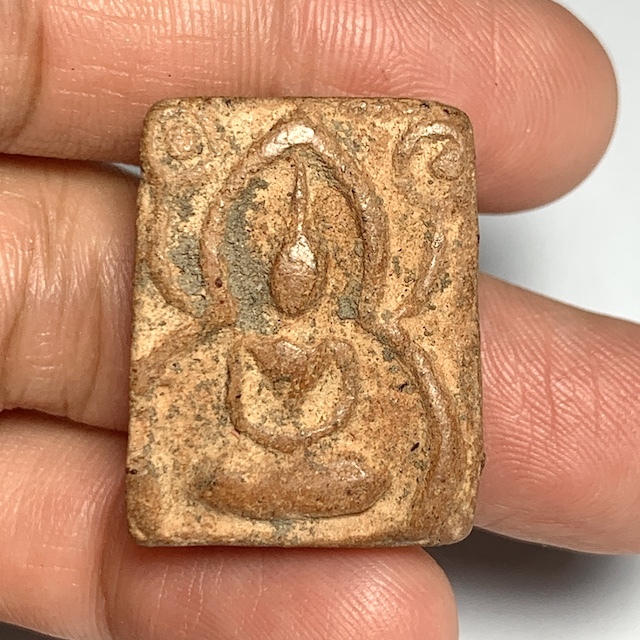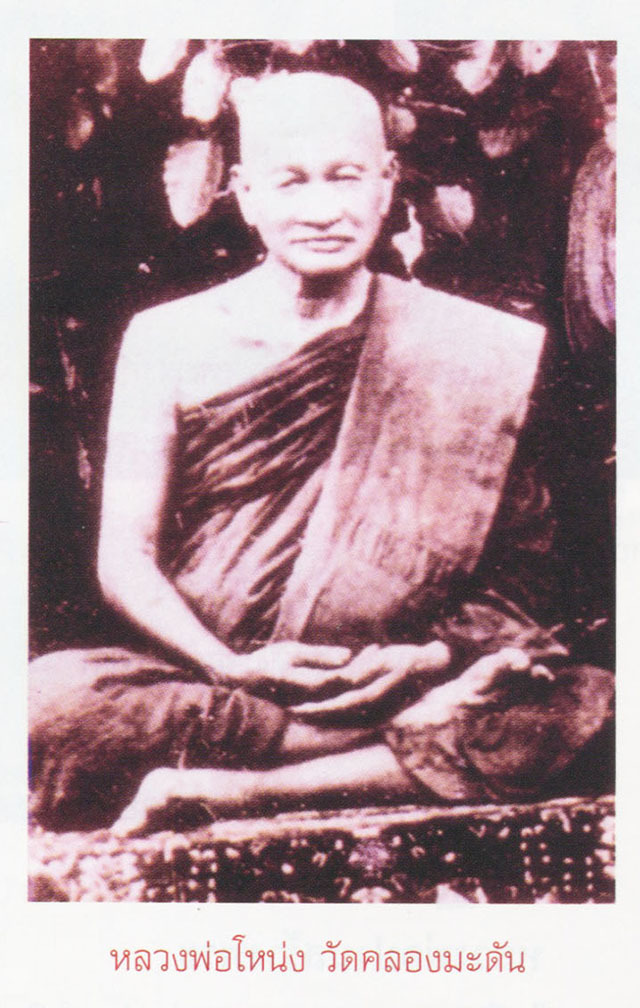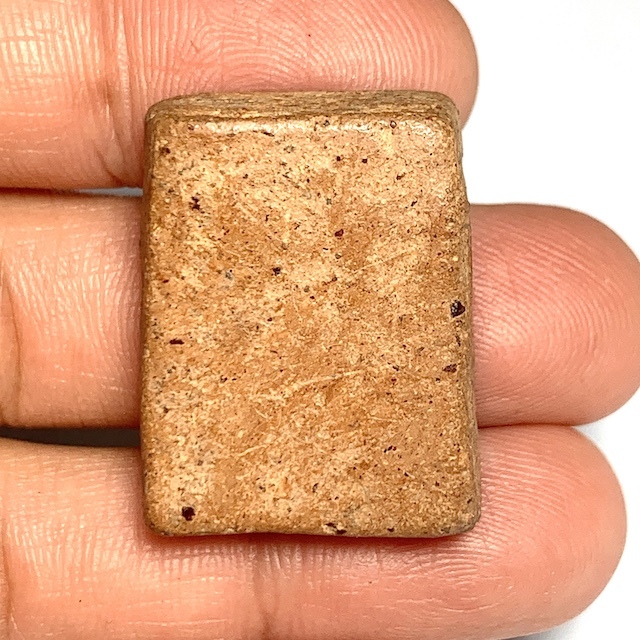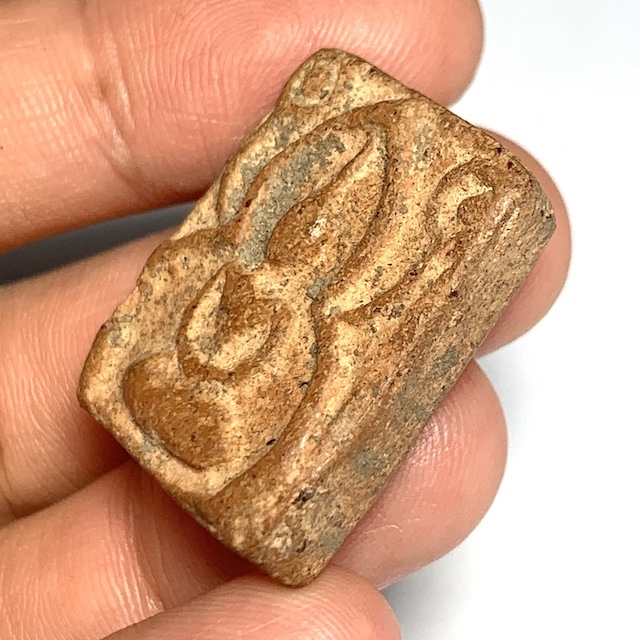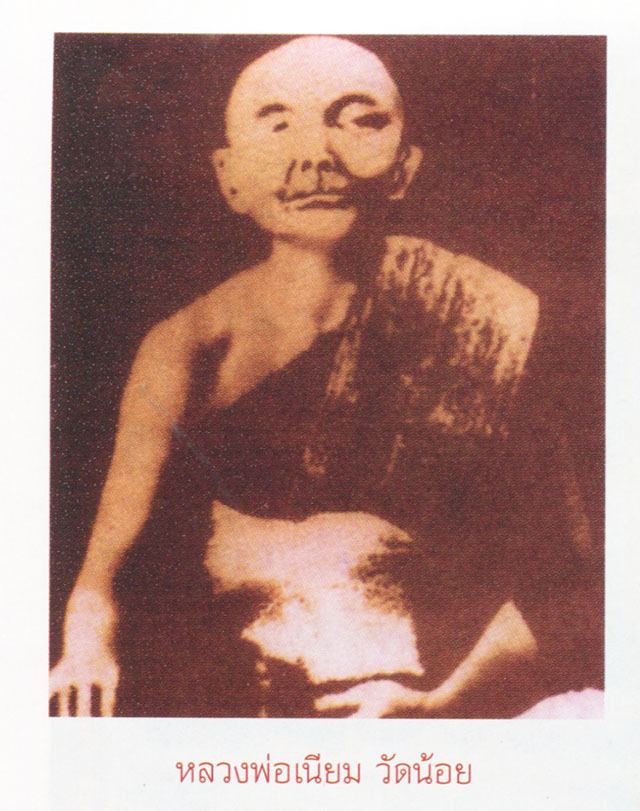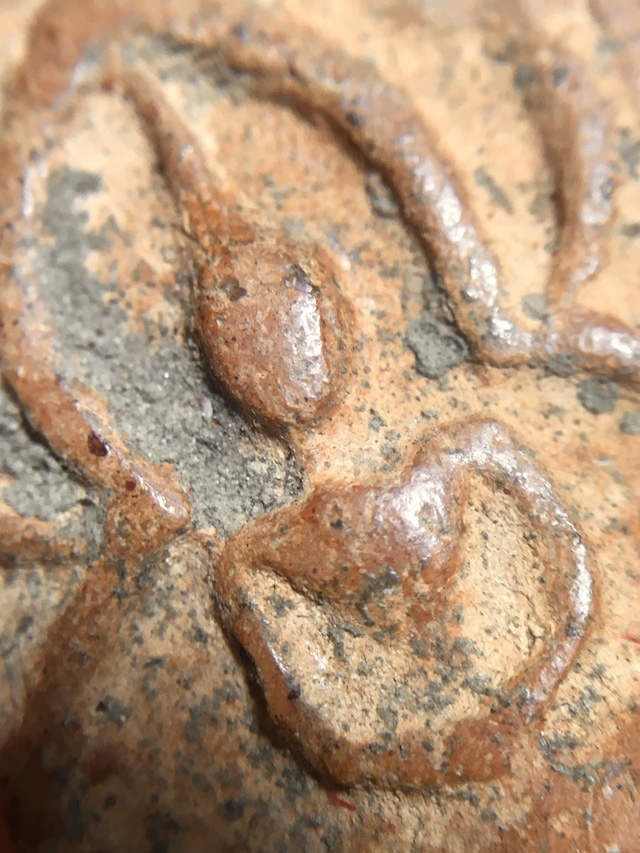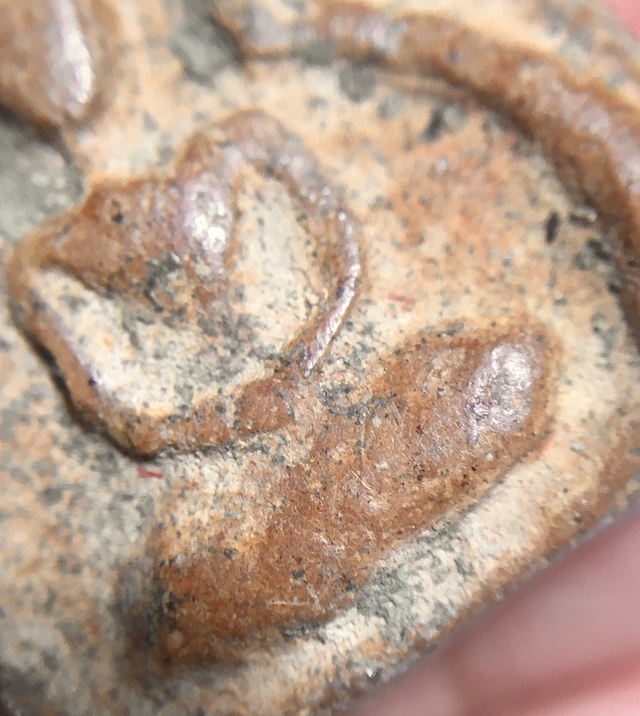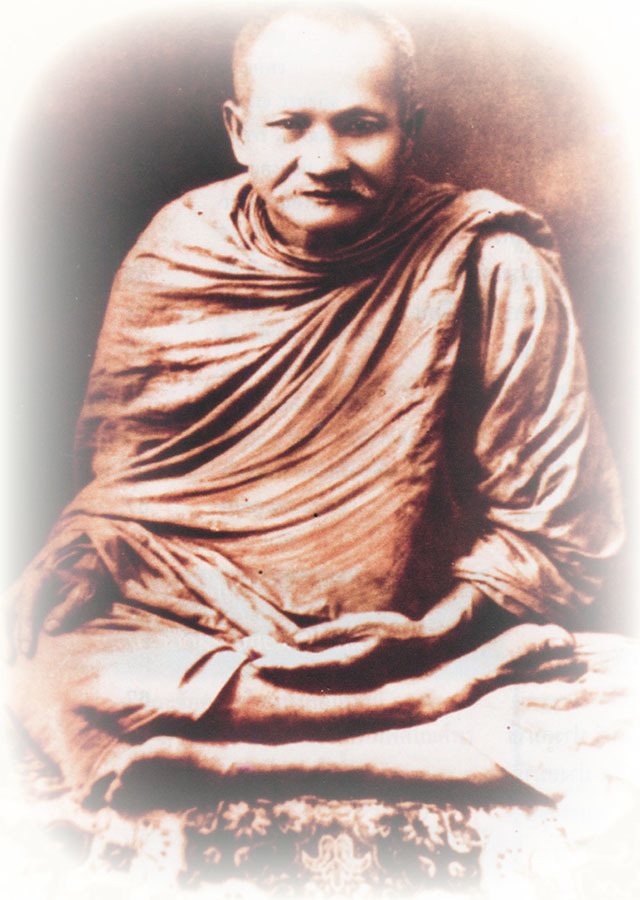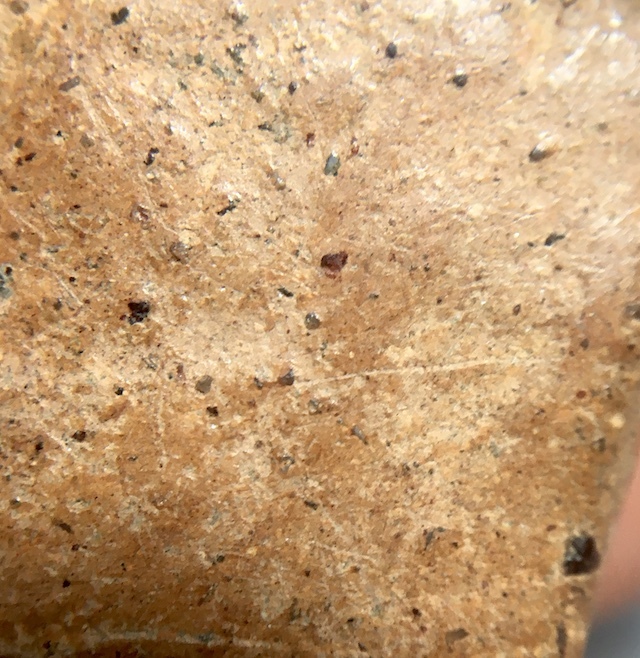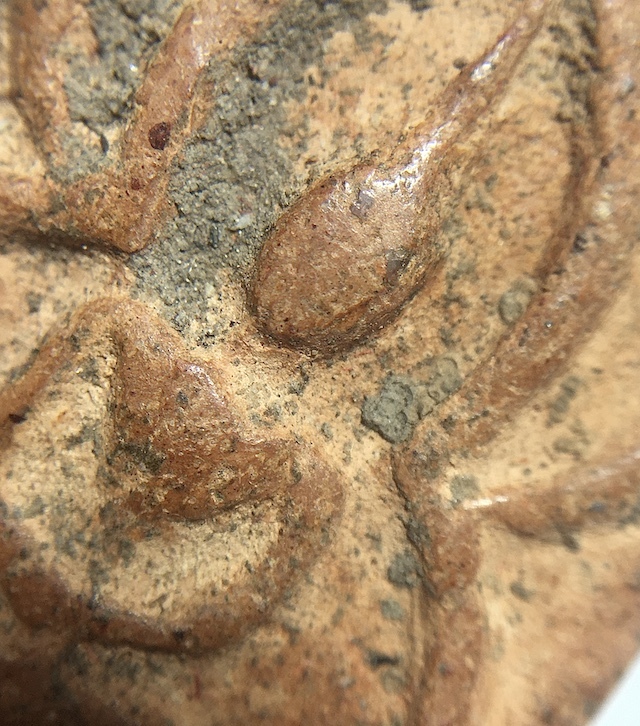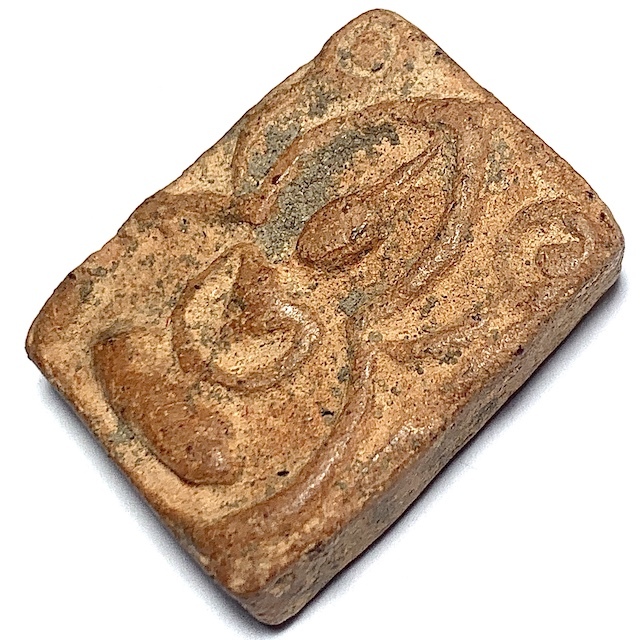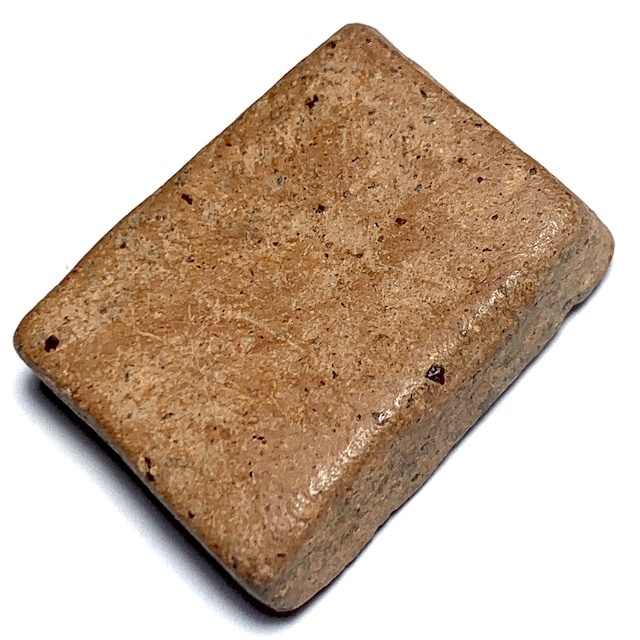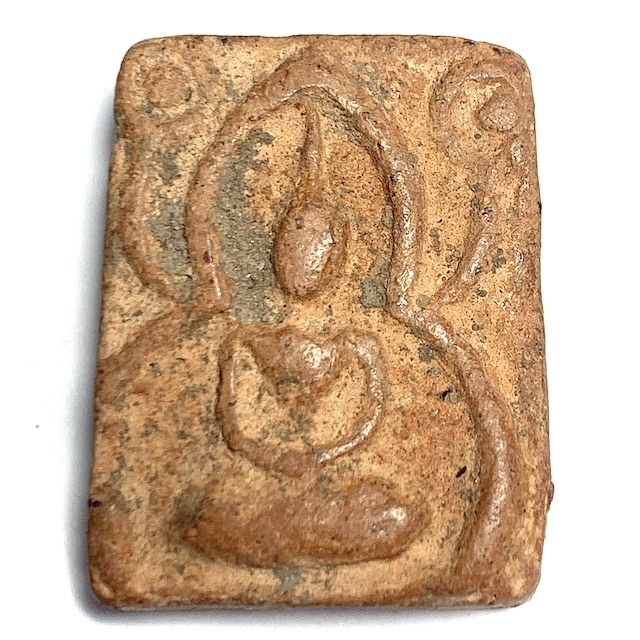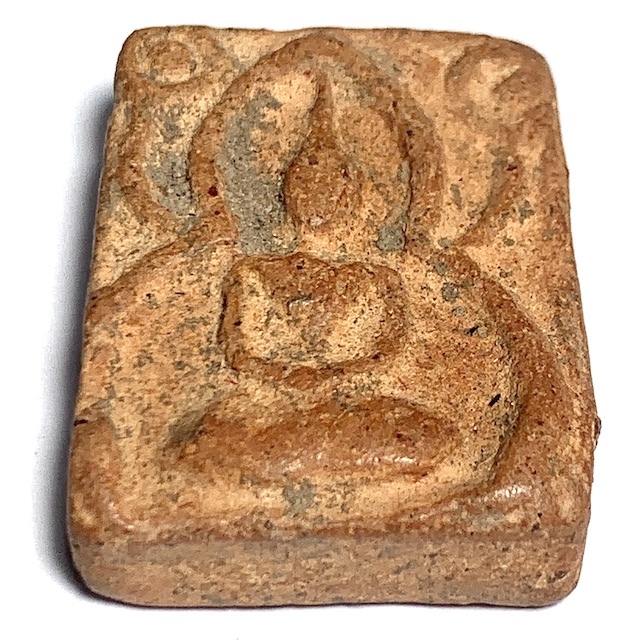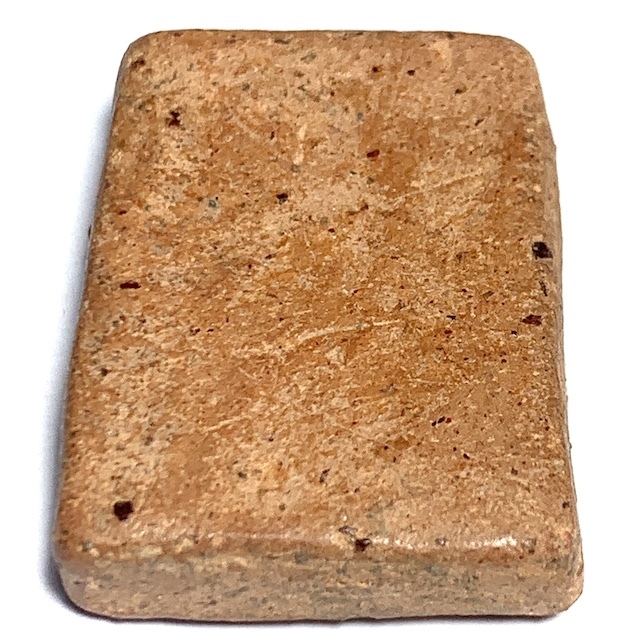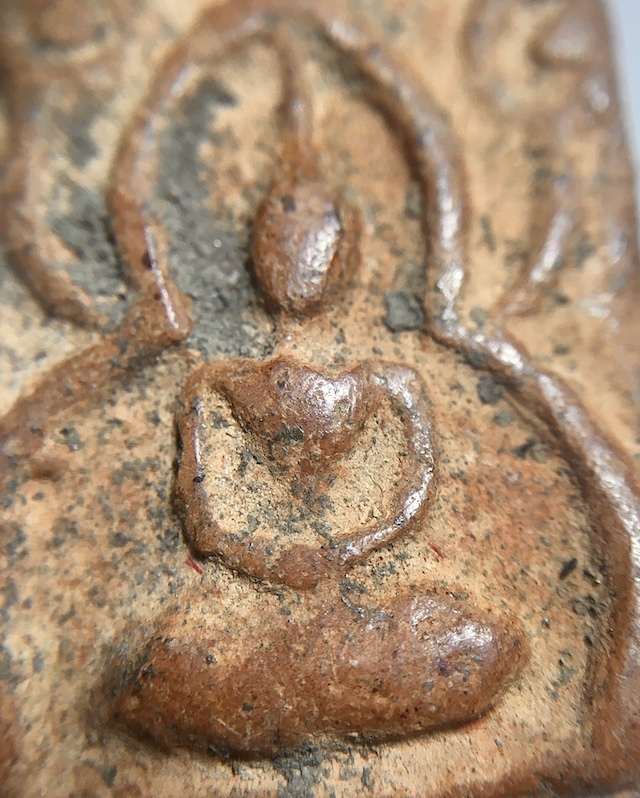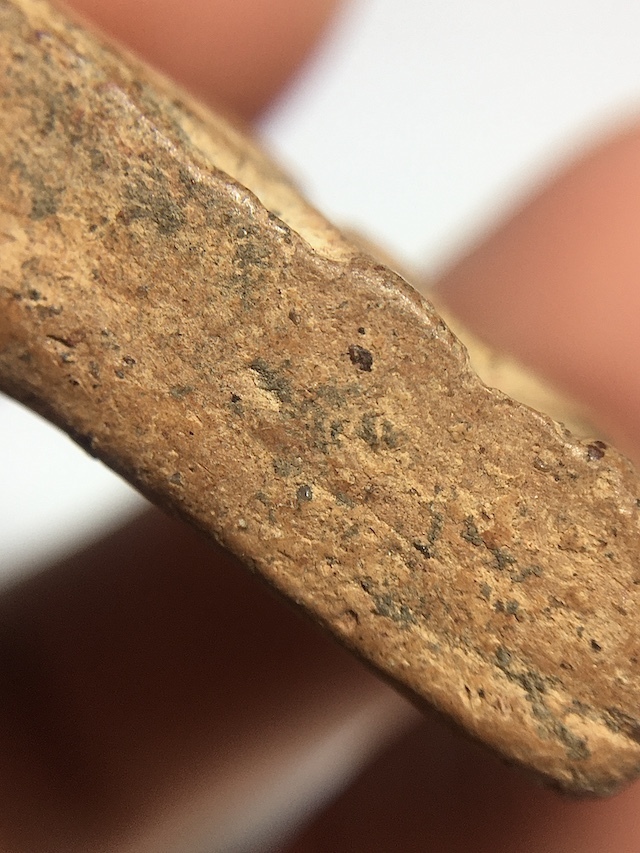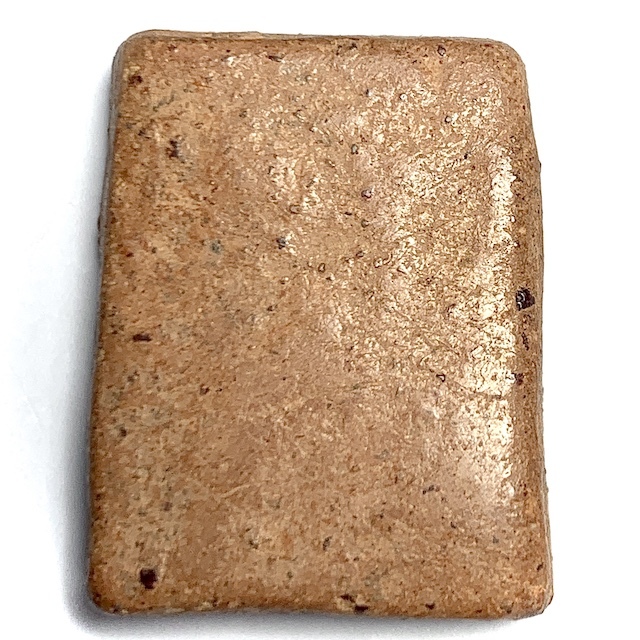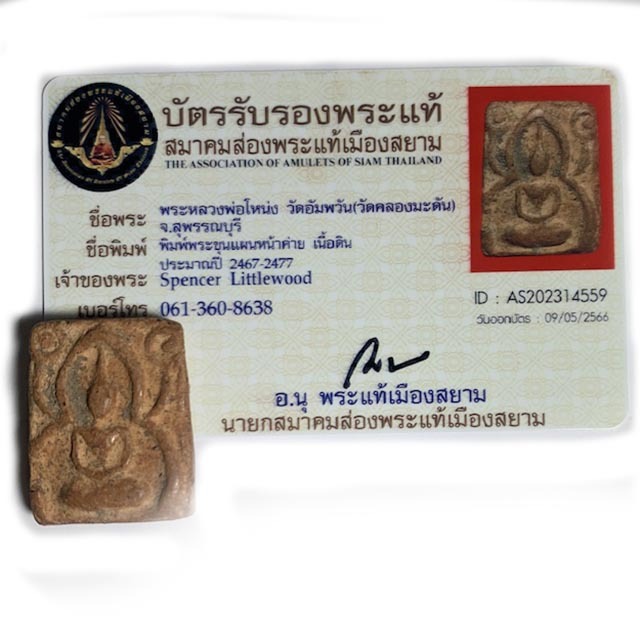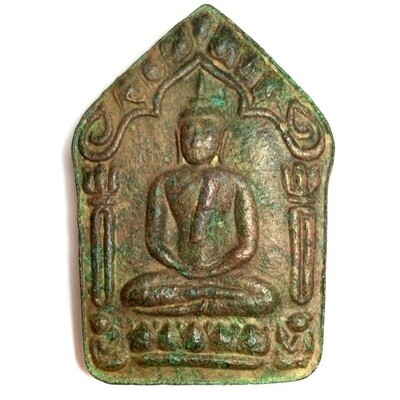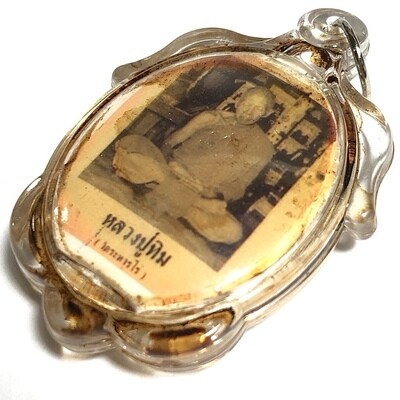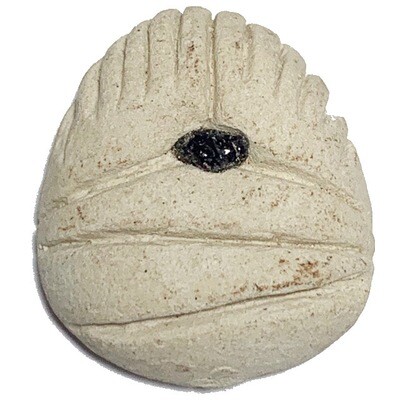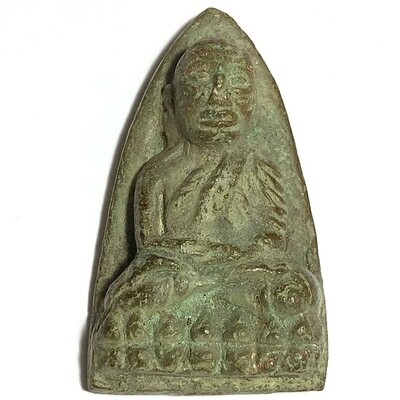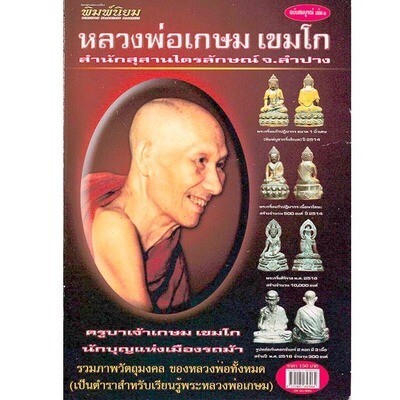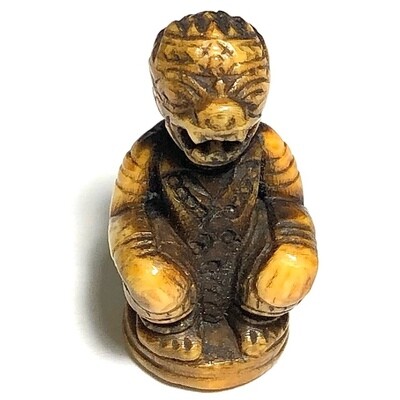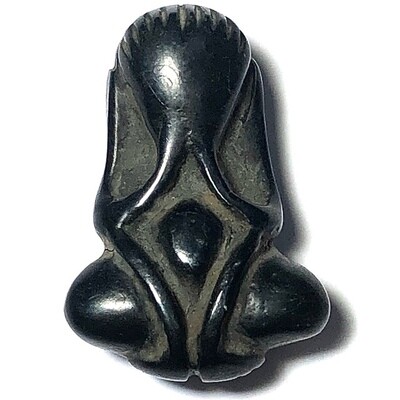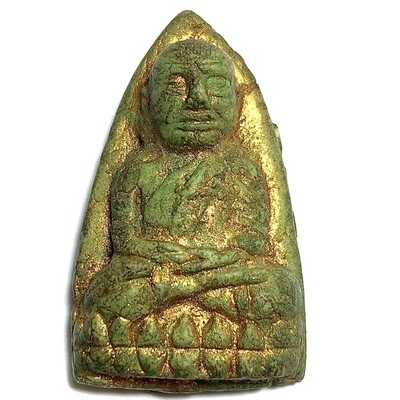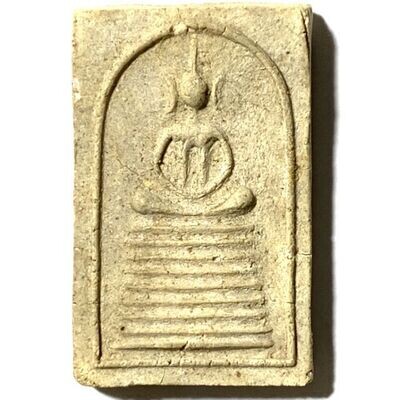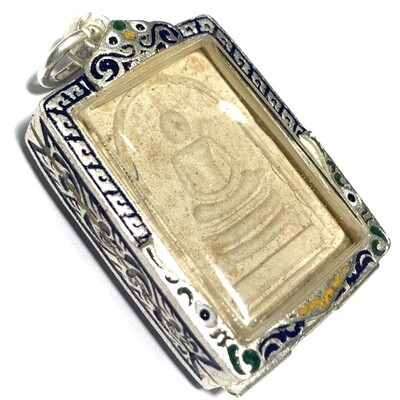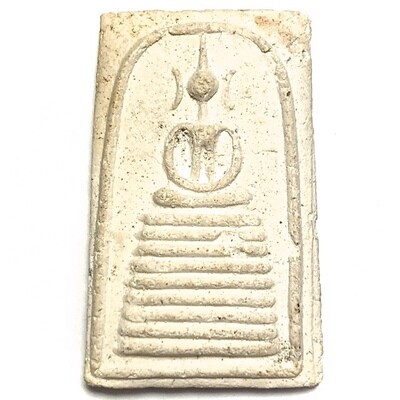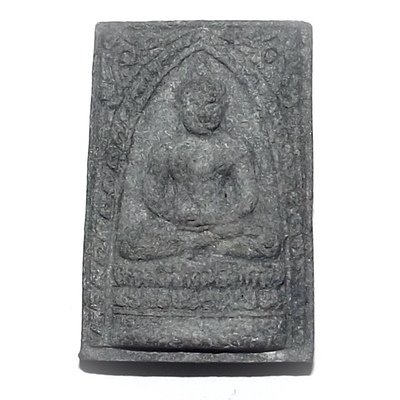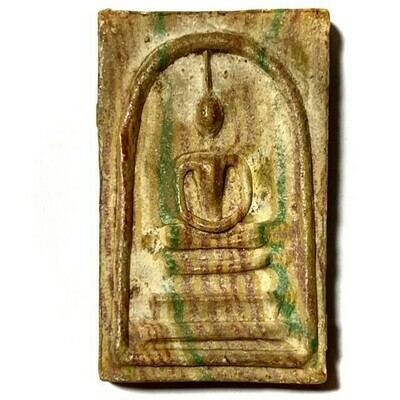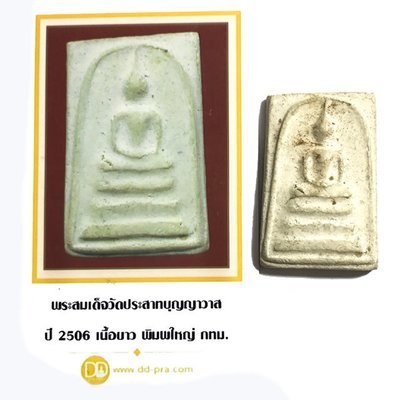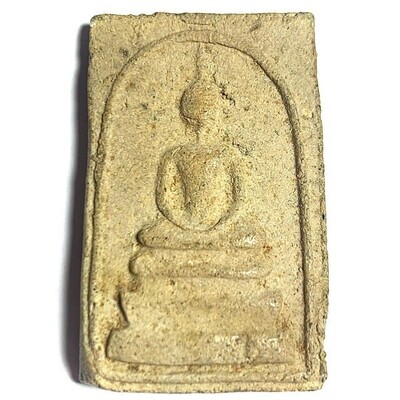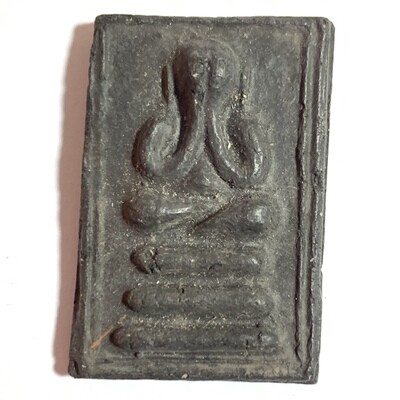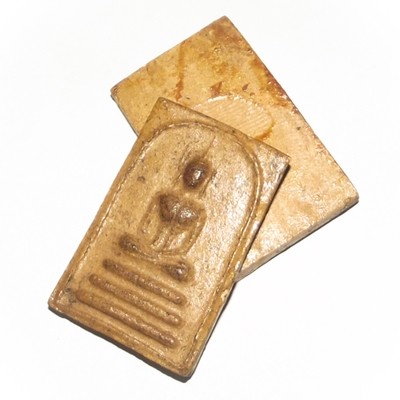Presenting a tiny but powerful and rare classic amulet from one of the Great Khao Or Masters of the 20th Century, Rian Glom Lek Hlang Chedi 2505 BE Nuea Tong Daeng Miniature Guru Monk Coin Por Tan Klai Wajasit
This Sacred amulet of the Great Khao Or Master of Nakorn Sri Tammarat, Master of Wat San Khan and Wat Pratat Noi, is a very rare amulet from Por Tan Klai’s 2505 BE Blessing Ceremony Edition, and is considered a ‘Jaek mae Krua’ type amulet (meaning ‘give to the kitchen maids and temple helpers’), which is suitable not only for men, but due to its miniature size, a perfect amulet for ladies or children to wear.

Rian Glom Lek 2505 BE Por Tan Klai Wajasit Wat Suan Khan
The 2505 BE edition of amulets of Por Tan Klai, is a highly preferred edition, which saw his famous ‘Rian Glom’ round Monk coin amulet with Chakra released, The Rian Glom Lek Hlang Chedi, and the Roop Tai Por Tan Klai Guru Monk Blesséd Photographamulets such as look om chan hmak and ya sen tobacco balls, and sacred powder amulets of various models.
A very rare and highly prized amulet for the devotees of Por Tan Klai to associate with his image and pray to him with a blessed image of the Guru, and the Chedi Relic Stupa on rear face for Buddhanussati and Marananussati. A powerful and Sacred amulet which has passed through the hands of the Guru and been blessed by him.
Por Tan Klai was one of the Top Guru Master Monks of the Last Century, and is considered one of the Four Great Masters of the Previous Generation of Lineage Masters of the Khao Or Southern Sorcery Lineage.
Kata Bucha Por Tan Klai
Khun Phaen Hnaa Kaay Nuea Din Pim Thaan Mai Mee Bua Luang Por Hnoeng Wat Klong Madan With Authenticity Certificate
A certificated authentic and fine exhibit of the inimitable and world famous, and immensely rare to find Pra Khun Phaen Hnaa Kaay amulet, this exhibit being the Pim Thaan Mai Mee Bua (no lotus dais mold) version, of this Ancient Master-Class amulet of the Great Ancient Sorcerer Monk, LP Hnoeng, of Wat Kong Madan. The highly coveted Pra Khun Phaen Hnaa Kaay amulet, is believed to have been crafted around 2461 BE, is an exquisite rarity that allures collectors of rare and sacred amulets. These treasured artifacts, so scarce in nature, have become sought-after gems primarily found in esteemed auction rooms, distinguished magazines, and esteemed masterpiece shops. It is with great fortune that we have come across a few of these genuine rarities and now have the privilege to offer them in our store.
Below; Luang Por Hnoeng of Wat Klong Madan
Luang Por Hnoeng, whose 'Chaya' (full ordained name) is 'Inthasuvanno', was born in the year 2408 B.E. This corresponds to the end of the reign of King Chulalongkorn (Rama V) of the Chakri Dynasty. He was born in Ban Tan, Song Phi Nong District, as the second child of Mr. To and Mrs. Joi. He had a total of nine siblings. Luang Por Hnoeng entered the monk-hood in 2432 B.E. at Wat Song Phi Nong. His preceptor was Phra Ajahn Chan from Wat Thung Khok, and his chanting teacher was Phra Ajahn Dit and Phra Ajahn Athikan, respectively. Since his ordination, Luang Por Hnoeng remained Vegetarian, respecting the act of not contributing to the hunting or death of animals, and never ate meat again.
Below : Authenticity Certificate from the Association of Amulets of Siam Thailand
After his ordination, Luang Por Hnoeng resided at Wat Thung Khok for two years and then spent seven years at Wat Song Phi Nong. He later moved to Wat Klong Madan and resided there until his passing. Luang Por Hnoeng became the abbot of Wat Klong Madan, and worked tirelessly to renovate and develop the temple. He passed away on 25th December 2477 B.E. during the reign of King Bhumibol Adulyadej (Rama IX). He lived for 69 years and spent 45 years as a monk.
During his monastic journey, he had the privilege of being guided by notable mentors and teachers. One of them was Luang Por Niam, a respected monk from Wat Noi in Suphanburi. Luang Por Niam recognized the exceptional qualities of Luang Por Hnoeng and spoke highly of him, stating that if he were to pass away, Luang Por Hnoeng could serve as a worthy replacement and provide guidance in matters of the Dharma.
Below : Luang Por Niam
This acknowledgment demonstrated the depth of Luang Por Hnoeng's knowledge and expertise in Buddhist teachings and practices. Furthermore, Luang Por Parn, another most prominent figure in the Buddhist community, also had the privilege of learning from both Luang Por Hnoeng and Luang Por Niam. Luang Por Parn, who resided at Wat Bang Nom Kho in Ayutthaya, regarded both Luang Por Hnoeng and Luang Por Niam as his mentors and Kroo Ba Ajarn (teachers).
One can see the Wicha of Luang Por Hnoeng present in the Muan Sarn Sacred Powders of the amulets of Luang Por Parn of Wat Bang Nom Kho quite evidently in fact, revealing how Luang Por Parn inherited much of Luang Por Hnoeng's ancient methods of empowerment, which made the amulets of both masters so popular both back then in the day, right up to the present era.
Below : Luang Por Parn of Wat Bang Nom Kho - Famous Geji Ajarn, and Looksit to Luang Por Hnoeng
The teachings of Luang Por Hnoeng's ancient Kroo Ba Ajarn, played a significant role in his spiritual development and the imparting their wisdom and knowledge to him. The bond between Luang Por Hnoeng, Luang Por Niam, and Luang Por Parn highlights the interconnectedness and lineage of teachings within the Thai Buddhist tradition.
Their guidance and teachings have had a profound impact on the lives of many practitioners and have contributed to the preservation and dissemination of Buddhist wisdom. Luang Por Hnoeng, like many other revered Thai Buddhist miracle-monks, was known to create and consecrate various types of amulets, which are believed by devotees to possess immensely powerful spiritual and protective qualities of Serm Yos, Kong Grapan Chadtri, Klaew Klaad, Maha Amnaj, Kaa Khaay and Metta Maha Niyom/Maha Sanaeh.
The specific designs and materials used in the amulets made by Luang Por Hnoeng may vary. Some amulets may feature his image or a representation of a revered Buddhist figure, such as various postures of the Buddha. Others may have sacred symbols, inscriptions, or Yant (sacred geometric designs). The materials used in bis amulets can include sacred chanuan alchemical metals, such as bronze or silver, or sacred substances like blessed earths, pollens, herbal powders, bamboo, woods, oils, or ashes.
Amulets made by Luang Por Hnoeng are sought after by believers for their perceived protective, auspicious, or spiritually beneficial properties. People may wear these amulets as a form of personal protection, to enhance their luck, or to support their spiritual practice. It's important to note that the efficacy and significance of amulets can vary depending on individual beliefs and interpretations. Luang Por Hnoeng was known for creating amulets primarily using clay or Muan Sarn Sacred Powders. These amulets were carefully crafted and consecrated by the monk, imbuing them with spiritual energy and blessings. The sacred powders used in these amulets might have been mixed with other sacred substances, such as relics or blessed funereal ashes, to enhance their potency. One can also notice the presence of sacred elements such as black grains of Lek Lai Kaya Siddhi Adamantine Substance in his earthen clay amulets.
In addition to clay or Muan Sarn Sacred Powder amulets, Luang Por Hnoeng also created Takrut scrolls. Takrut is a type of cylindrical amulet made from a rolled-up piece of metal sheet or parchment inscribed with sacred prayers or yant. These Takrut scrolls are believed to provide various forms of protection and blessings to the wearer.
The amulets created by Luang Por Hnoeng, whether made of clay, Muan Sarn Sacred Powders, or Takrut scrolls, were highly regarded by his followers and collectors. These amulets were sought after for their perceived spiritual qualities and believed to bring good fortune, protection, and support in various aspects of life. It is important to note that the efficacy and significance of amulets, including those made by Luang Por Hnoeng, are deeply rooted in individual beliefs and faith. Collectors and wearers often attribute personal experiences and positive outcomes to the power and blessings of these amulets.
Luang Por Hnoeng was a highly respected monk known for his dedication to the monastic life, his commitment to vegetarianism, and his efforts in temple renovation and development. Luang Por Hnoeng made several notable achievements and contributions during his time as the abbot of Wat Mai Amphan. Some of these include: Renovation and Development: Luang Por Hnoeng dedicated himself to the renovation and development of Wat Klong Madan. Under his leadership, the temple underwent significant improvements and expansions. He worked tirelessly to enhance the physical structures of the temple, including the ordination hall, meditation halls, living quarters for the monks, and other facilities. Spiritual Guidance and Teaching: Luang Por Hnoeng was renowned for his spiritual guidance and teaching. He provided instruction and guidance to the monks and laypeople who sought his wisdom.
As a highly respected monk, he shared Buddhist teachings, conducted ceremonies, and guided people in their spiritual practice. Preservation of Buddhist Tradition: Luang Por Hnoeng played a crucial role in preserving and upholding the traditions of Thai Buddhism. He placed great emphasis on the study and practice of Buddhist scriptures, rituals, and meditation techniques. Through his teachings and example, he helped ensure the continuity of the Buddhist tradition and its values. Community Service: Luang Por Hnoeng actively engaged in community service and social welfare activities.
He supported many charitable initiatives throughout his trajectory, and encouraged the local community to participate in acts of kindness and generosity. His compassionate and benevolent actions inspired others to follow his path and contribute to the well-being of society. Through his dedication to the renovation and development of Wat Klong Madan, his spiritual guidance, preservation of Buddhist traditions, community service, and the establishment of Dhamma centers, Luang Por Hnoeng left a significant impact on the temple and the people who came into contact with him. He is remembered as a revered master monk who made valuable contributions to the Buddhist community and society as a whole.
Luang Por Hnoeng's teachings and guidance had a profound impact on the local community. Here are some ways in which his teachings influenced and benefited the people:
1. Moral and Ethical Guidance: Luang Por Hnoeng emphasized the importance of moral and ethical conduct based on Buddhist principles. His teachings on virtues such as kindness, compassion, honesty, and generosity inspired the local community to lead virtuous lives. His guidance served as a moral compass, guiding people in making ethical choices and cultivating positive qualities.
2. Spiritual Development: Luang Por Hnoeng provided spiritual guidance and teachings that helped individuals deepen their understanding of Buddhism and develop their spiritual practice. Through his instructions on meditation techniques and the exploration of Buddhist doctrines, he supported individuals in their spiritual growth and the cultivation of inner peace and wisdom.
3. Community Unity and Harmony: Luang Por Hnoeng's teachings promoted unity and harmony within the local community. He emphasized the practice of loving-kindness and encouraged people to resolve conflicts through peaceful means. His teachings fostered a sense of togetherness, mutual respect, and cooperation among community members, creating a harmonious and supportive environment.
4. Social Welfare and Charity: Luang Por Hnoeng actively engaged in community service and charitable activities, inspiring the local community to do the same. His teachings on generosity and compassion motivated people to contribute to the welfare of others. Under his guidance, the community initiated and participated in various charitable endeavors, such as providing support to the underprivileged, organizing merit-making activities, and offering assistance during times of crisis.
5. Personal Guidance and Counseling: Luang Por Hnoeng provided personal guidance and counseling to devotees who sought his advice. He offered support and guidance in various aspects of life, including relationships, personal challenges, and spiritual dilemmas. His compassionate presence and wise counsel brought comfort and clarity to those in need, helping them navigate their life's challenges with wisdom and resilience.
Overall, Luang Por Hnoeng's teachings and guidance had a transformative effect on the local community. His emphasis on moral conduct, spiritual development, community unity, social welfare, and personal guidance contributed to the well-being, spiritual growth, and moral fabric of the community members who were fortunate enough to receive his teachings and guidance.
Luang Por Hnoeng's amulet pantheon includes 'Pra Din Phao (baked earthen clay amulets), both in rough and finely detailed forms, Pra Bucha statues, Talismanic Charms (i.e. Takrut etc), and Muan Sarn Sacred Powders and Earthen amulets such as the Pra Sum Gor, Pra Lila walking Buddha, Pra Khun Phaen Pra Somdej 3 Chan, Pra Pruhnang, Pra Ngop Nam Oy (Sugar Cake Yantra) Pra Pim Gleep Bua, Pra Pimp Dtri Gaay, Pra Jao Ha Pra Ongtk (5 Buddha amulet), Pra Pid Ta, Pra Nakprok, Pra Pim Paang Saiyasana, Pra Pim Kampaeng Sork, and other rare design molds. The most preferred and well known amulets of Luang Por Hnoeng in the high end collector scene, are of course the Pim Khun Phaen Hnaa Kaay, and the Pim Sum Gor, which is found in both Pim Yai (large) and Pim Lek (small) versions.
During Luang Por Hnoeng's tenure as the abbot, he focused on preserving and upholding the traditions of Thai Buddhism. He provided spiritual guidance, taught Buddhist principles, and played an instrumental role in the temple's growth. Luang Por Hnoeng's impact on Wat Klong Madan and the surrounding community was significant, and his efforts are still revered by followers and visitors.
While specific historical details about Wat Klong Madan may be limited, the temple's longevity and the contributions of great monks like Luang Por Hnoeng, have shaped its identity as an important religious site in Thailand. Today, Wat Klong Madan continues to receive devotees of Luang Por Hnoeng, who is still remembered as the Top Master of living memory of the temple, and serves as a place of worship, meditation, and community engagement for devotees and visitors alike.
The amulets of Luang Por Hnoeng are revered objects that hold significant religious and spiritual value. Luang Por Hnoeng began creating these sacred items at an unknown time in the past, but there is evidence of one particular amulet with a burnt clay inscription on the back indicating the year 2461 in the Buddhist era (BE). This inscription leads to the assumption that Luang Por Hnoeng started crafting these amulets around that time since no earlier Buddhist era dates are mentioned.
These amulets are highly regarded for their exceptional virtues and popularity. They are believed to possess benevolent powers, offer protection, and maintain stability. The monetary value of these amulets among collectors varies and depends on the satisfaction of both the buyer and the seller during exchanges. However, for newcomers and aspiring owners, it is advisable to seek guidance from knowledgeable experts and experienced collectors before making a decision to acquire or worship these amulets.
This precaution is necessary because there is currently a proliferation of counterfeit amulets, both new and old, in circulation. This certificated model is hence a valuable assurance for less experienced collectors who do not yet have their own abilities to authenticate with their own eyes and knowledge, for peace of mind of authenticity, and to know one has a perfect reference model in one's possession for study and further learning, as well as of course, receiving the magical blessings and power of the world famous Pra Khun Phaen Hnaa Kaay of Luang Por Hnoeng.
